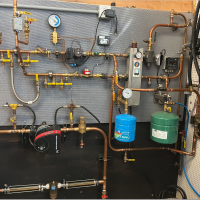Help me calculate pressure drop!
My nominally 140K BTU/hr Weil-McLain CGa-2 boiler was only firing at 120K BTU/hr when I actually clocked it at the meter. I had the plumber that services it attempt to increase the pressure last fall, but that was as high as it would go. I called the utility company to have someone come out and check the pressure, and they increased the pressure at the meter from 5.3" w.c. to 6" w.c., which resulted in an increased firing rate of 130K BTU/hr without additional tweaks to the boiler. I'd really like to get this thing firing at nominal for efficiency reasons, so I'd like some help figuring out if the piping to the boiler is the issue.
From where the line comes in from the meter (about 2' away), I have 2 x 90* elbows, a 22' run of 1" pipe, another 90* elbow, a 27' run of 1" pipe, a tee that goes from 1" diameter to a 6" run of 3/4"-diameter pipe, followed by a reducer to 1/2" diameter. I then have a final 5' run of 1/2" pipe down to the boiler, another 90* 1/2" elbow, and then a final 8" of 1/2" pipe before it enters the gas valve.
Would replacing the final ~6' of 1/2" pipe with 1" pipe fix things? The boiler says it needs a minim of 5" w.c. inlet pressure. Thoughts/suggestions welcome.
Comments
-
If that’s NG, we usually get 7”.
8.33 lbs./gal. x 60 min./hr. x 20°ΔT = 10,000 BTU's/hour
Two btu per sq ft for degree difference for a slab0 -
If I added it right you have roughly 60' of pipe. With 140000 btuu you should have 1" all the way, thats the way it would be if piped properly.
you have 6.0"wc now at the meter and the boiler needs 5.0". I don't know if increasing the last 6' of pipe will help but it should.
You should also be combustion testing the boiler if you playing with the gas pressure.
Why are you increasing the firing rate ? Does the boiler heat the house now?
1 -
do you need more output?
If not running at a lower firing rate and a more constant run will be most efficient
If you running condensing mode, a small firing rate in a large hx equals more condensation , higher efficiency
The combustion analyzer is important for dialing in an efficient burn
Bob "hot rod" Rohr
trainer for Caleffi NA
Living the hydronic dream2 -
What is the supply pressure to the boiler with the boiler firing? If it is over the ratings plate the piping isn't your problem. What is the manifold pressure? Your meter could be off.
Without doing the math my gut feeling is the drop in that tiny section of .5. Is very small.
0 -
Oh, what pressure is the index on the meter calibrated for? If the pressure doesn't match the index the reading will be wrong
0 -
Thanks all.
- ConEd only guarantees they'll supply between 4"-7" w.c. at the meter, even though my boiler lists that the minimum at the boiler should be 5".
- The guy that services my boiler used a combustion analyzer and it showed 76% combustion efficiency (with 117% excess air) for my nominally 84% efficiency CI, atmospheric boiler. @mattmia2 He used a manometer and diagnosed the pressure at the valve was dropping to like 4.3" w.c. when firing (which agreed with the clocked-at-the-meter 120KBTU/hr vs nominal 140KBTU/hr. He suggested I call the utility to see if they could increase the gas pressure. I waited until this summer (I generally don't like to mess with anything heat-related in the winter), and after discussing the issue with the technician that showed up, he was able to increase the pressure at the meter from 5.3" to 6". I test-fired the boiler once to see if it made an obvious difference (and it did - 120K BTU/hr to 130K BTU/hr), but otherwise intend to have it checked and combustion tested by my normal heating guy before heating season.
- The boiler was about 4x oversized when it was only drawing 120K BTU/hr, so it's not a 'can this keep my house warm?' issue, I was just trying to see if I could improve on the '76% combustion efficiency when it should read 84%' part. I'm extremely familiar with the efficiency issues involved with oversizing, but the thermal purging scheme I bolted on to my boiler appears to be extremely effective at distributing the BTUs that don't go up the flue, so I was hoping to improve on that part. This is a non-condensing, fixed-firing-rate boiler.
- No idea re: meter calibration.
0 -
That seems like a big change in excess air for a 10%or so change in firing rate.
Are you measuring before the draft hood adds more excess air?
Are the covers all in place?
If it is a model that requires installation on a solid non combustible surface is the bottom sealed off? It isn't on blocks at the corners or blocks with open cores or open joints?
0 -
-
@mattmia2 - Yes, the measurement point was below the draft hood, the covers were in place and it's sitting directly on a level, unfinished concrete floor. The combustion results (when it was clocking at 120KBTU/hr, and we measured inadequate pressure at the boiler) were:
- CO2max:11.8%
- O2:10.2%
- CO:4 PPM
- Ambient CO: 0 PPM
- Excess air: 117.7%
- CO2: 5.42%
- Undiluted CO: 9 PPM
- Combustion Efficiency: 76%
@GroundUp - The 'efficiency' I'm discussing is purely how many BTUs go out the flue vs make it into the boiler+water during combustion, and should be what is measured with the combustion analyzer. I think you're discussing 'system efficiency' due to oversizing / low duty cycle / etc. losses. Both of those were pretty bad initially, but I think I've adequately solved the 'system' side of things with a custom thermal purge scheme using a PLC, which leaves me wanting to improve the combustion efficiency side of things (I don't have a chance to distribute BTUs if they've already gone out the flue).
0 -
Are you sure about that? Underfiring causes high excess air and is a main cause of OP’s poor efficiency. Calculate true combustion efficiency off of O2 and net stack temp (don’t have OP's numbers) and the efficiency probably drops into the mid 60’s
0 -
-
@fentonc I am referring to combustion efficiency. Your analysis shows a grossly rich mixture, which is what is causing any efficiency detriment. This is not the fault of underfiring, it is the fault of poor combustion.
@HydronicMike his numbers are listed above, and yes I'm sure.
1 -
@GroundUp - can you elaborate on that? I'm not a professional, but my understanding was that the results I was seeing were due to insufficient fuel for the boiler geometry (hence very high excess air, lots of left over O2, etc.), which matched the boiler having low gas pressure and being clocked 15% lower than its nominal rating. If you think there is an alternative explanation I am very curious.
0 -
you could put bigger orifices in it and drop the manifold pressure but i would find someone that knows combustion very well to do that.
without the actual static and dynamic pressure numbers of the system we are just guessing.
the gas meter measures volume so the index needs to match the pressure at the meter or the reading will be wrong.
0 -
-
My apologies- I saw 11.8%, not 5.42%. I was wrong.
0 -
@GroundUp No problem I have made the same mistake looking at the combustion #s confusing.
0 -
So is my diagnosis of "too much pressure drop" —> "lower than target efficiency" probably correct? My expectation would be that, assuming adequate air intake and such, at 140K BTU/hr input it should hit the nominal ~84% efficiency number.
0 -
it will hit the 84% in a lab set up to perform the doe efficiency test.
You can probably get it instantaneously closer by increasing the firing rate but you need to make sure it is still within regulation, that the pressure won't go up if the main or building pressure goes up. The overall system efficiency may or may not be better or may be worse at the higher firing rate because it will run shorter cycles and you will have more losses associated with starting and ending the cycle but it will be slightly more efficient combustion wise when it is firing.
0 -
New question - what combustion efficiency numbers do people typically see for well-tuned, non-modulating cast iron boilers out in the field?
0 -
83-84%
Your not doing that bad but you are short of gas. This is a problem found in older cities with aging infrastructure. I would hazard a guess your in an "older neighborhood"
Basically although the utilities will not admit it their underground piping leaks like a seive. They could easily raise the pressure if their pipes didn't leak.
When I was young and stupid (instead of old and stupid like now) I had a conversation with a gas utility where we were installing a 5,000,000btu gas burner and they could only give us 6"wc. I kept asking him why they couldn't raise the pressure and couldn't get a straight answer.
Finally he said "if we raise the pressure we give away a lot of free gas" Took me a min to understand what he was saying.
I did a job in a town in CT where they would only say we could get 4" of wc. The equipment we were installing needed 10" wc. It worked after we installed a 30K gas booster pump.
0 -
fortunately in an atmospheric boiler you can change the orifices and run at a lower manifold pressure.
0 -
don't forget it is summer now and demand is low, the main pressure could be significantly worse in the middle of winter.
this is the real reason for the push for electrification so instead of fixing the leaking distribution system they can just abandon it.
0 -
The more a boiler, typical with oversized boilers, cycle , the lower the efficiency
So steady state or lab tested could show 82-84%, cycle efficiency could drag it down into the 70%
but that will always be the challenge with a non modulating boiler. 80% of the year it is oversized, even if it is spot in sizing for design day.So a combustion analyzer showing burner efficiency is not telling all of the story.
My opinion is a mod con, even on a high temperature system will run in the mid 80s throughout its firing range. High 80 or 90 if it can condense part of the time.
Bob "hot rod" Rohr
trainer for Caleffi NA
Living the hydronic dream1
Categories
- All Categories
- 87.3K THE MAIN WALL
- 3.2K A-C, Heat Pumps & Refrigeration
- 61 Biomass
- 429 Carbon Monoxide Awareness
- 120 Chimneys & Flues
- 2.1K Domestic Hot Water
- 5.8K Gas Heating
- 115 Geothermal
- 166 Indoor-Air Quality
- 3.7K Oil Heating
- 77 Pipe Deterioration
- 1K Plumbing
- 6.5K Radiant Heating
- 395 Solar
- 15.7K Strictly Steam
- 3.4K Thermostats and Controls
- 56 Water Quality
- 51 Industry Classes
- 50 Job Opportunities
- 18 Recall Announcements


